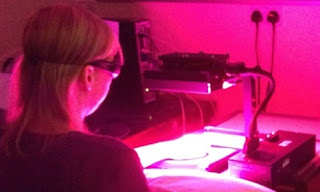Light therapy shows potential for treating ulcers in systemic sclerosis
Prof.Dr.Dram,profdrram@gmail.com,Gastro Intestinal,Liver Hiv,Hepatitis and sex diseases expert 7838059592,9434143550
A novel light therapy which combines infrared, red and violet light emitted through LEDs* appears safe and improves the conditions of finger ulcers in patients with systemic sclerosis (SSc), a pilot study shows.
“Despite there being treatments available to prevent digital ulcers [DUs] recurrent ulceration remains a major source of morbidity in patients with SSc … [and] these treatments are often poorly tolerated,” the researchers pointed out.
“There is a strong therapeutic rationale to develop ‘locally’ acting treatments for DUs, which would likely be well tolerated by patients (ie, without systemic vasodilation) and could potentially avoid the need for hospitalization to administer intravenous therapies,” they continued.
After 46 light exposures on 14 DUs in eight patients (mean age 48.5 years, 87.5 percent female), their ulcer status improved, as indicated by a significant reduction in DU visual analogue score (VAS) from baseline: by 82.8 percent based on patient’s perception and by 74.9 percent based on clinician’s report at week 8. [J Dermatolog Treat 2018;doi: 10.1080/09546634.2018]
In fact, improvements were seen over the study period, with global DU VAS improving by -7.1 units for patients and -5.2 units for clinicians at each visit (p<0.001 for both). DU appearance also improved by 0.14 units (p=0.01), based on photographs graded by an independent, blinded assessor.
Furthermore, light therapy significantly increased DU perfusion by 0.32 (p=0.0013) at the DU centre (DUCore) and by 0.15 (p=0.04) at the DU periphery, as measured using laser Doppler imaging.
“We successfully administered the light treatment to DUs located on a variety of locations on the hands, including in patients with marked finger contractures,” stated the researchers, who noted that the light device can potentially be used to treat other ulcers, such as diabetic and venous ulcers.
“The local increase in DU perfusion with light treatment may obviate the systemic vasodilation inherent in most current treatment approaches to SSc-related DU,” they added.
The device is custom built and comprised LEDs emitting violet (405 nm), red (660 nm), and infrared (850 nm) wavelengths. DUs were irradiated with all three wavelengths simultaneously at a total dose 10 J/cm2 each time, twice weekly for 3 weeks. Participants were followed up at weeks 4 and 8.
Red or infrared lights are believed to promote wound healing while violet light has been associated with antimicrobial properties. [Semin Cutan Med Surg 2013;32:41-52; Photomed Laser Surg 2006;24: 684-688]
“Our targeted novel [light therapy] was safe, feasible, and well tolerated by patients …. We believe this technology is a game changer; the implications are huge,” said lead author Dr Hughes Moore of the University of Manchester, UK. “Ulcers cause much distress to patients … this technology is cheap and practical- it's really a no brainer as it can be administered at home.”
“There are future possibilities as well: we think this device could be easily adapted to monitor ulcers remotely using cameras. They could also be programmed to recognize different parts of the body so that the treatment is given accurately,” he said. “In the next 6 to 12 months we shall be refining the machine and within 12 months we hope to trialling it on diabetic ulcers.”
- Kidney stones universally present hazard in north india,dillution by water prevent it
- Steroid and placebo effect equally for mild persisting asthma with low sputum eosinophils
- Government wants to fix public healthcare staff shortages with ayush docs: will it work?
- Plea in hc for payment of salaries of edmc, north mcd teachers and doctors
- 7 indian pharma companies named in us lawsuit over inflating generic drug prices
- Woman in up dies after explosion in her mouth during treatment,what is diagnosis?
- Woman in up dies after explosion in her mouth during treatment,what is diagnosis?
- Woman in up dies after explosion in her mouth during treatment,what is diagnosis?
- Air pollution ! mothers organising rally in london,anaesthetist choosing gas,will india follow?
- Cardiac arrest is always not sudden as understood -a study


 Comments (
Comments ( Category (
Category ( Views (
Views (